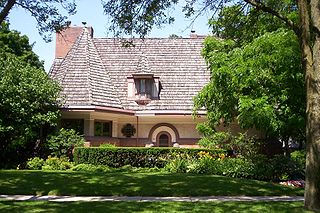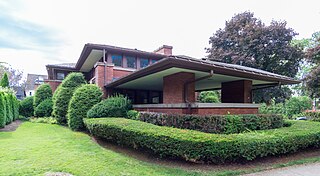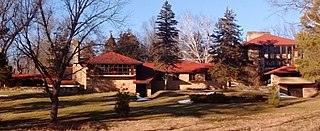
Frank Lloyd Wright Sr. was an American architect, designer, writer, and educator. He designed more than 1,000 structures over a creative period of 70 years. Wright played a key role in the architectural movements of the twentieth century, influencing architects worldwide through his works and hundreds of apprentices in his Taliesin Fellowship. Wright believed in designing in harmony with humanity and the environment, a philosophy he called organic architecture. This philosophy was exemplified in Fallingwater (1935), which has been called "the best all-time work of American architecture".

The Darwin D. Martin House Complex is a historic house museum in Buffalo, New York. The property's buildings were designed by renowned architect Frank Lloyd Wright and built between 1903 and 1905. The house is considered to be one of the most important projects from Wright's Prairie School era.

The Chauncey L. Williams House, in River Forest, Illinois is a residence designed by Frank Lloyd Wright. The house was built in 1895 of Roman brick and plaster. It was one of Wright's earliest Chicago commissions.

The Graycliff estate was designed by Frank Lloyd Wright in 1926, and built between 1926 and 1931. It is approximately 17 miles southwest of downtown Buffalo, New York, at 6472 Old Lake Shore Road in the hamlet of Highland-on-the-Lake, with a mailing address of Derby. Situated on a bluff overlooking Lake Erie with sweeping views of downtown Buffalo and the Ontario shore, it is one of the most ambitious and extensive summer estates Wright designed. It is now fully restored and operates as a historic house museum, open for guided tours year round. There is also a summer Market at Graycliff, free and open to the public on select Thursday evenings. Graycliff Conservancy is run by Executive Director Anna Kaplan, who was hired in 2019.
Henry-Russell Hitchcock (1903–1987) was an American architectural historian, and for many years a professor at Smith College and New York University. His writings helped to define the characteristics of modernist architecture.

The William and Jessie M. Adams House is a Prairie school style house located at 9326 South Pleasant Avenue in Chicago, Illinois.

The Foster House and Stable is a Japanese-influenced house at 12147 South Harvard Avenue in the West Pullman neighborhood of Chicago, Illinois, United States. The house was designed in 1900 by Frank Lloyd Wright as a summer home for Stephen A. Foster, an attorney who worked for real estate developer who helped to build this part of the West Pullman neighborhood. It was designated a Chicago Landmark on May 9, 1996.

The American System-Built Homes were modest houses in a series designed by architect Frank Lloyd Wright. They were developed between 1911 and 1917 to fulfill his interest in affordable housing but were sold commercially for just 14 months. The Wright archives include 973 drawings and hundreds of reference materials, the largest collection of any of single Wright project. Wright cancelled the project in July of 1917 by successfully suing his partner Arthur Richards for payments due and didn't speak of the program again. The designs were standardized, and customers could choose from one hundred and twenty nine models on seven floorpans. Because of this standardization, the lumber could be milled at a factory, thereby cutting down on both waste and the amount of skilled labor needed for construction. The buildings are often termed prefabricated homes, but they were not, since prepared materials were delivered to the work site for construction by a carpenter. Windows, doors and some cabinetry were made at the factory. Frames, shelves, trim and some fixtures were cut and assembled on site. Every milled profile had a part number and corresponding instructions and drawings for construction. Many extant homes remain in private hands and an ad hoc homeowners group sometimes meets to share ideas. Six structures are located in a federal historic district in Milwaukee, Wisconsin, and others have been designated Chicago Landmarks in Chicago, Illinois.

The Edward C. Waller Apartments are located from 2840 to 2858 W. Walnut Street in Chicago, Illinois. They were designed by Frank Lloyd Wright and built in 1895 and named after Edward C. Waller, a prominent Chicago developer after the 1871 fire. Waller and Wright collaborated on the Waller apartments and the Francisco Terrace apartments to execute Waller's pioneering idea of subsidizing lower income housing. Each apartment was designed with a parlor, chamber (bedroom), dining room, kitchen, bathroom, and closets.

The Frank L. Smith Bank, now known as the Dwight Banking Center ofPeoples National Bank of Kewanee, is a bank building in Dwight, Illinois, United States that was designed by American architect Frank Lloyd Wright. Wright's earliest designs for the building date to 1904, but it was constructed in 1905 and opened in 1906. The design of the bank building deliberately rejects the classical influences common at the time, and is meant to evoke an air of simple dignity.
Isabel Roberts was a Prairie School figure, member of the architectural design team in the Oak Park Studio of Frank Lloyd Wright and partner with Ida Annah Ryan in the Orlando, Florida architecture firm, "Ryan and Roberts".

The Charles L. and Dorothy Manson home is a single-family house located at 1224 Highland Park Boulevard in Wausau, Wisconsin. Designated a National Historic Landmark, it was listed on the National Register of Historic Places on April 5, 2016, reference Number, 16000149.

The William R. Heath House was designed by Frank Lloyd Wright, built from 1903 to 1905, and is located at 76 Soldiers Place in Buffalo, New York. It is built in the Prairie School architectural style. It is a contributing property in the Elmwood Historic District–East historic district and a City of Buffalo landmark.

The Thomas P. Hardy House is a Frank Lloyd Wright-designed Prairie school home in Racine, Wisconsin, USA, that was built in 1905. The street-facing side of the house is mostly stucco, giving the residents privacy from the nearby sidewalk and street, but the expansive windows on the other side open up to Lake Michigan.

The Walter V. Davidson House, located at 57 Tillinghast Place in Buffalo, New York, was designed by Frank Lloyd Wright and built in 1908. It is an example of Wright's Prairie School architectural style. The house is a contributing property to the Parkside East Historic District, a neighborhood laid out by renowned American landscape architect Frederick Law Olmsted in 1876, and also a City of Buffalo landmark.

Midway Gardens was a 360,000 square feet indoor/outdoor entertainment facility in the Hyde Park neighborhood on the South Side of Chicago. It was designed by architect Frank Lloyd Wright, who also collaborated with sculptors Richard Bock and Alfonso Iannelli on the famous "sprite" sculptures decorating the facility. Designed to be a European–style concert garden with space for year-round dining, drinking, and performances, Midway Gardens hosted popular performers and entertainers but struggled financially and the structure was torn down in October 1929.

The Hillside Home School II was originally designed by architect Frank Lloyd Wright in 1901 for his aunts Jane and Ellen C. Lloyd Jones in the town of Wyoming, Wisconsin. The Lloyd Jones sisters commissioned the building to provide classrooms for their school, also known as the Hillside Home School. The Hillside Home School structure is on the Taliesin estate, which was declared a National Historic Landmark in 1976. There are four other Wright-designed buildings on the estate : the Romeo and Juliet Windmill tower, Tan-y-Deri, Midway Barn, and Wright's home, Taliesin.

William G. Fricke House is a home by American architect, Frank Lloyd Wright, in Oak Park, Illinois, United States. Fricke commissioned the home in 1901 and it was finished the next year. Wright used elements in the building that would appear in his Prairie style homes: a high water table, horizontal banding, overhanging eaves, shallow hipped roofs, and an exterior with an expansive amount of stucco. Wright usually emphasized the horizontal in his house designs, but the Fricke house is different by having a three-story tower.

The William E. Martin House is a Prairie style home designed in 1902 by American architect Frank Lloyd Wright in the Chicago suburb of Oak Park, Illinois, United States. W.E. Martin was inspired to commission Wright for a home after he and his brother, Darwin D. Martin drove around Oak Park looking at Wright's homes. After meeting with Wright, William Martin excitedly wrote his brother, "I've been—seen—talked to, admired, one of nature's noblemen—Frank Lloyd Wright."

The George Blossom House in Chicago was designed by architect Frank Lloyd Wright in 1892, while Wright was still working in the firm of Adler and Sullivan. As Wright was working as a draftsman for Adler and Sullivan, he was forbidden from taking outside commissions. He later referred to these designs as his "bootleg houses".


















